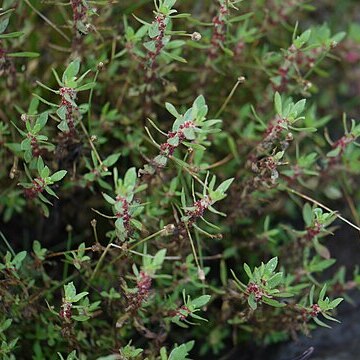Herbs annual, 8-30 cm tall. Stem richly branched at base; branches erect or obliquely ascending, densely glandular hairy and puberulous. Stipules 2-fid, ca. 2 mm, submembranous, lobes lanceolate, margin laciniate-denticulate; leaf blade oblanceolate, obovate-lanceolate, or narrowly elliptic, 0.6-2 cm × 2-8 mm, abaxially puberulous and sparsely glandular hairy on veins, adaxially sparsely puberulous or glabrous, base oblique or attenuate, margin serrate, apex acute. Flowers numerous and clustered in leaf axils, small; pedicel 1-2 mm. Sepals narrowly ovate, 1-2 mm, abaxially often villous and glandular hairy, margin membranous, apex acuminate. Petals reddish, narrowly ovate or elliptic, subequaling sepals, apex mucronate. Stamens 5; filaments filiform, base slightly widened. Ovary ovoid; styles 5; stigmas capitate. Capsule subglobose, ca. 2 mm in diam., 5-septicidal. Seeds brown, narrowly ovoid, ca. 0.5 mm, inconspicuously reticulate-striate.
Prostrate or erect herb to 40 cm, annual. Indumentum of eglandular hairs with occasional long glandular hairs lacking a terminal globular head. Leaves narrow-elliptic to elliptic, 8–25 mm long, 3–8 mm wide, acute, glabrous or sparse hairs usually restricted to base or veins, margin serrate, veins prominent. Stipules 1.5–2 mm long, c. 0.5 mm wide at base. Flowers in dense fascicles; pedicel to 4 mm long. Bracteoles inconspicuous, at base of pedicel, linear, c. 1 mm long. Sepals 5, narrow-ovate, 1.2–2 mm long, c. 0.5 mm wide, acute to acuminate, green, pubescent, margin narrow, fimbriate, keel absent. Petals 5, ± equal to sepals, narrow-ovate, 1.5–2 mm long, c. 0.5 mm wide, acute, erect at anthesis. Stamens 5, c. 1 mm long, filament base slightly expanded. Capsule globular, 1.5–2 mm diam., 5-locular; styles c. 0.25 mm long, stigmas capitate. Seeds ellipsoid, 0.25–0.3 mm long, c. 0.15 mm wide, light brown, faintly striate.
Leaves opposite, sessile or with a very short petiole in our material not exceeding 2 mm. in length; leaf-lamina 0·6–5 × 1·5–2 cm., oblanceolate or oblong-elliptic, acute or blunt at the apex, cuneate and narrowing gradually into the petiole, margin distantly serrulate or almost entire, teeth often pink, with filamentous hyaline hairs on both sides or glabrescent; stipules 2–3 mm. long, lanceolate to subulate, membranous with ciliolate or serrulate margins.
Sepals 1–1·3 × 0·4–0·5 mm., lanceolate, acute or acuminate, somewhat keeled with the keel pilose or ciliolate, margins membranous and hyaline, ciliolate or entire or often only one margin ciliolate the entire margin being that covered by the adjacent imbricate sepal.
Small erect or decumbent annual, branched or with simple often pinkish stems, pilose with the hairs often capitate, or sometimes quite glabrous, occasionally reaching 30 cm. tall but usually a good deal less.
Flowers white or pinkish, in dense verticillate clusters, subsessile or on slender pubescent pedicels c. 1 mm. long; bracts c. 1 mm. long, linear or linear-lanceolate, membranous, ciliolate.
Ovary c. 1 mm. in diam., globose, longitudinally 5-ribbed, 5-locular, glabrous, many-ovuled; styles 5, very short, c. 0·2 mm. long, swollen and subcapitate at the stigmatic apices.
Stamens 5–12, with the alternate ones slightly longer and with filaments usually slightly broader towards the base, the longer c. 1 mm., the shorter c. 0·7 mm. long.
Petals equalling or almost equalling the sepals in length, slightly narrower, lanceolate or oblanceolate, blunt at the apex.
Seeds c. 0·4 × 0·22 mm., subcylindric with rounded ends, dark brown, shining, very minutely tessellated longitudinally.
Fruit a crustaceous capsule, 1–2 mm. in diam.


